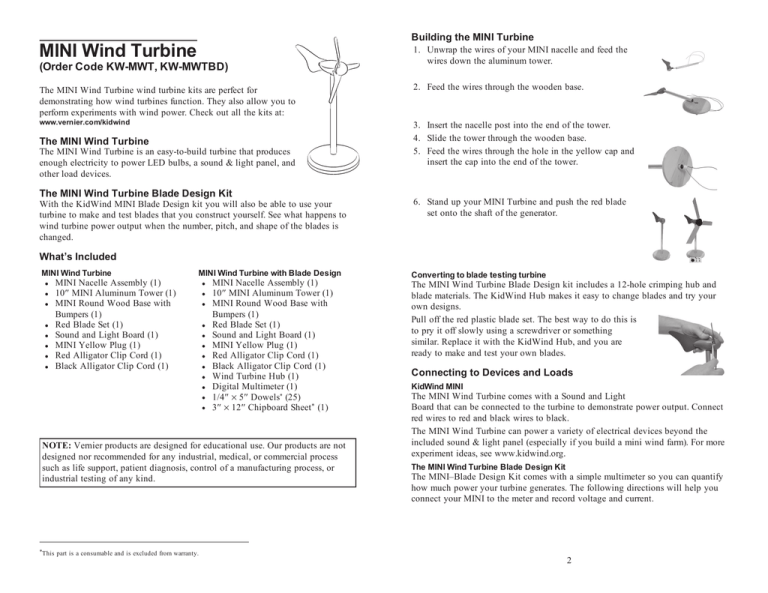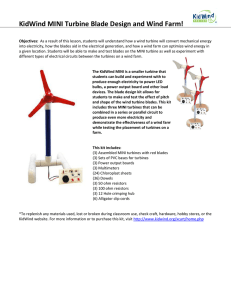MINI Wind Turbine
advertisement

Building the MINI Turbine MINI Wind Turbine (Order Code KW-MWT, KW-MWTBD) 1. Unwrap the wires of your MINI nacelle and feed the wires down the aluminum tower. The MINI Wind Turbine wind turbine kits are perfect for demonstrating how wind turbines function. They also allow you to perform experiments with wind power. Check out all the kits at: 2. Feed the wires through the wooden base. www.vernier.com/kidwind 3. Insert the nacelle post into the end of the tower. 4. Slide the tower through the wooden base. 5. Feed the wires through the hole in the yellow cap and insert the cap into the end of the tower. The MINI Wind Turbine The MINI Wind Turbine is an easy-to-build turbine that produces enough electricity to power LED bulbs, a sound & light panel, and other load devices. The MINI Wind Turbine Blade Design Kit With the KidWind MINI Blade Design kit you will also be able to use your turbine to make and test blades that you construct yourself. See what happens to wind turbine power output when the number, pitch, and shape of the blades is changed. 6. Stand up your MINI Turbine and push the red blade set onto the shaft of the generator. What’s Included MINI Wind Turbine MINI Nacelle Assembly (1) 10″ MINI Aluminum Tower (1) MINI Round Wood Base with Bumpers (1) Red Blade Set (1) Sound and Light Board (1) MINI Yellow Plug (1) Red Alligator Clip Cord (1) Black Alligator Clip Cord (1) MINI Wind Turbine with Blade Design MINI Nacelle Assembly (1) 10″ MINI Aluminum Tower (1) MINI Round Wood Base with Bumpers (1) Red Blade Set (1) Sound and Light Board (1) MINI Yellow Plug (1) Red Alligator Clip Cord (1) Black Alligator Clip Cord (1) Wind Turbine Hub (1) Digital Multimeter (1) 1/4″ × 5″ Dowels* (25) 3″ × 12″ Chipboard Sheet* (1) NOTE: Vernier products are designed for educational use. Our products are not designed nor recommended for any industrial, medical, or commercial process such as life support, patient diagnosis, control of a manufacturing process, or industrial testing of any kind. *This part is a consumable and is excluded from warranty. Converting to blade testing turbine The MINI Wind Turbine Blade Design kit includes a 12-hole crimping hub and blade materials. The KidWind Hub makes it easy to change blades and try your own designs. Pull off the red plastic blade set. The best way to do this is to pry it off slowly using a screwdriver or something similar. Replace it with the KidWind Hub, and you are ready to make and test your own blades. Connecting to Devices and Loads KidWind MINI The MINI Wind Turbine comes with a Sound and Light Board that can be connected to the turbine to demonstrate power output. Connect red wires to red and black wires to black. The MINI Wind Turbine can power a variety of electrical devices beyond the included sound & light panel (especially if you build a mini wind farm). For more experiment ideas, see www.kidwind.org. The MINI Wind Turbine Blade Design Kit The MINI–Blade Design Kit comes with a simple multimeter so you can quantify how much power your turbine generates. The following directions will help you connect your MINI to the meter and record voltage and current. 2 Measuring Voltage Attach the wires from the generator to a Vernier Energy Sensor or the multimeter. Polarity is not relevant at this point. When using a multimeter to check the voltage, select DC volt (V) and set the number to 20. Place your turbine out in the wind or in front of a fan and let it spin. It is normal for the voltage readings to fluctuate because of the inconsistent nature of the wind or unbalanced blades. Voltage is related to how fast the DC generator is spinning. The faster it spins, the higher the voltage. With no load on the generator, it has little resistance and can spin very fast. You can measure voltage with no load, but it is more realistic to place a resistor in the circuit and measure the voltage across the resistor. Use 10, 30, 50 or 100 ohm resistors. Measuring DC Voltage Measuring Current To calculate the turbine’s power output, you will need to measure current. Current is measured in milliAmperes. 1A = 1000 mA. To measure current, place a load (resistor) in series with a Vernier Current Sensor or Energy Sensor or a multimeter so that the generator is forced to do work. If using a multimeter, set the meter to 200 or 20 mA, which is a typical range for the MINI turbines. The current that the turbine produces depends on the load placed in the circuit and the torque the blades are generating. Measuring Current Typical output for the MINI: Voltage: 1–4 volts Amperage: 20–100 milliamps (0.020–0.1 amps) If your numbers have come out much higher than this, something is amiss. Check your units! Related Products Vernier Energy Sensor VES-BTA Vernier Variable Load VES-VL Vernier Resistor Board VES-RB Renewable Energy with REV Vernier lab book use to measure both current and voltage output of the generator variable load (resistor) resistor board with seven resistors lab book with 26 experiments for wind and solar energy energy Additional Resources V 20 Typical Output A 20 200 For more information about wind energy, see KidWind’s document, Learn Wind, available at http://learn.kidwind.org/sites/default/files/learn_wind.pdf Warranty This kit contains many parts. Parts in the kit, excluding consumables, are warranted for a period of five years. Consumables are clearly marked on Page 1 of the user manual. Voltage, Resistance, Current Voltage (measured in volts), is also called Resistor “potential difference” or “electromotive force” (EMF). It is a measure of the amount of “potential energy” available to make electricity flow in a circuit. It is the electric “pressure” causing the current to flow. Electric current is a measure of the rate at which electric charge (electrons) are flowing through a circuit. It is given in the unit of amperes (“amps”). Smaller amounts of current are often stated in milliAmps (mA). A mA is 1/1000 of an amp. Electrical resistance is the opposition to the flow of electricity. Measured in ohms, it reflects how much electric “pressure” (voltage) is required to push a given amount of current through part of an electric circuit. Power is the product of current and voltage. 3 Vernier Software & Technology 13979 SW Millikan Way • Beaverton, OR 97005-2886 Toll Free (888) 837-6437 • (503) 277-2299 • FAX (503) 277-2440 info@vernier.com • www.vernier.com Rev. 5/4/2015 Vernier and caliper design are our registered trademarks. Vernier Software & Technology and vernier.com are our trademarks or trade dress. The KidWind Project and KidWind are trademarks of The KidWind Project in the U.S. or other jurisdictions. Printed on recycled paper. 4


